Welcome to “Optimizing Grapes Orchard Maintenance: A Comprehensive Guide for Month-wise Planning”! In this captivating blog, we embark on a journey through the intricacies of grape cultivation, exploring the art of maintaining a flourishing orchard all year round. With a touch of creativity and a dash of expertise, we will unravel the secrets to maximizing grape yields, ensuring optimal vine health, and attaining grape-growing success like never before. Grape cultivation provides month-wise strategies that will leave you inspired and excited.
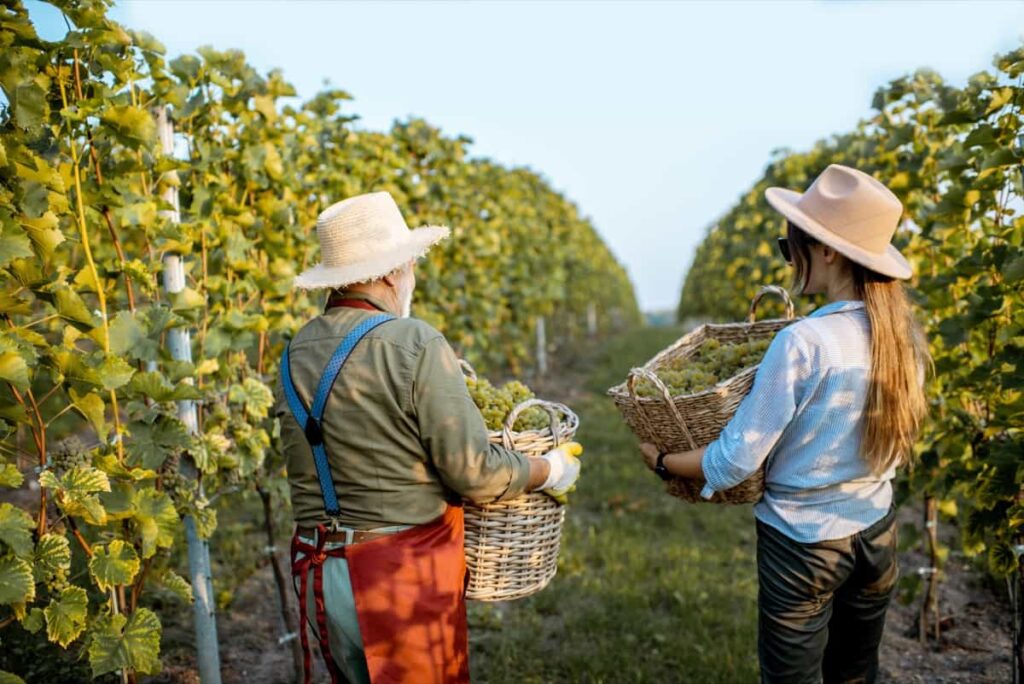
Grapes Orchard Management
What is Grapes Farming and its Overview?
Grapes, scientifically known as a berry, belong to the Vitis genus and grow on deciduous woody vines. They are considered a non-climacteric fruit and are commonly found in clusters. Grape cultivation dates back approximately 8,000 years, and grapes have played a significant role in human food consumption. Apart from being enjoyed fresh, grapes are dried to make raisins, currants, and sultanas. Furthermore, grapes hold cultural importance worldwide, particularly in winemaking. Additionally, grapes create various products such as jams, juices, vinegars, and oils.
Grapes exhibit diverse colors, including crimson, black, dark blue, yellow, green, orange, and pink. Surprisingly, “white” grapes are green and have evolved from purple grapes due to mutations in specific regulatory genes that disable anthocyanin production, responsible for purple grape coloration. The presence of anthocyanins and other pigment chemicals, part of the polyphenol family, contribute to the varying shades of purple in red wines. In terms of shape, grapes typically resemble an ellipsoid, similar to a prolate spheroid.
Importance of Month-Wise Planning for Grapes Orchard Maintenance
By implementing a well-structured plan, grape growers can strategically address various tasks and challenges specific to each month. During spring, pruning, training, and trellis maintenance focus on shaping the vines and promoting healthy growth. Summer months require attention to watering, pest control, disease prevention, and monitoring grape development. As autumn approaches, activities shift towards harvesting, proper storage, and post-harvest care. Finally, winter is the time for vineyard renovation, soil management, and preparation for the upcoming season.
Best Tips for Growing Grapes Orchard Maintenance Practices
Economic Importance: Grapes hold significant economic value as a fruit crop with multiple objectives, including table consumption, export, winemaking, and raisin production. Fresh grapes provide essential minerals like calcium, phosphorous, iron, and vitamins such as B. Additionally, renowned champagnes and other dessert wines are derived from grapes.
Climatic Requirements: Grapes thrive in a Mediterranean climate, growing and producing fruit during hot and dry periods. In South Indian conditions, the vine’s vegetative growth occurs from April to September, followed by the fruiting period from October to March. Temperatures between 10°C to 40°C impact yield and quality. High humidity and cloudy weather increase the risk of fungal diseases and affect the sugar-acid ratio.
Soil Preference: Grapes adapt well to various soil conditions, but the highest yield and quality are achieved on fertile soils with a pH range of 6.5 to 8.5, organic carbon content above 1.0%, free from lime, and possessing moderate water-holding capacity. Medium yield with high Total Soluble Solids (T.S.S.) can be obtained on medium-type soils.
In case you missed it: High Yield Hybrid Grapes Varieties in India: State Wise Varieties Cultivated
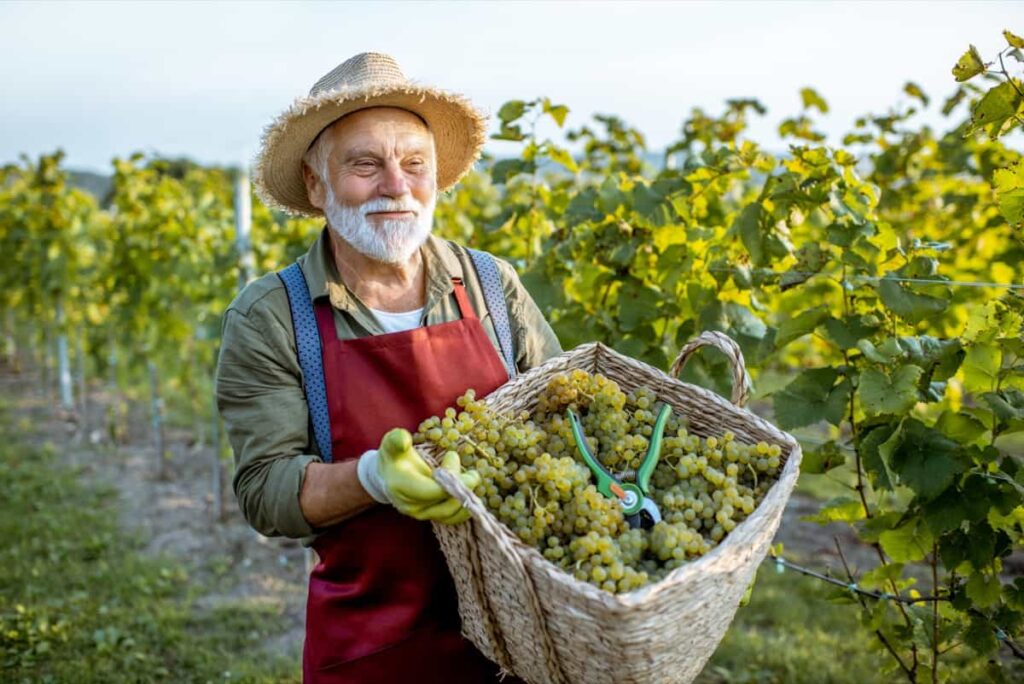
Varieties: Different grape varieties serve specific purposes:
- Table purpose varieties: Cardinal, Concord Emperor, Italia, Anab-e-Shahi, Cheema Sahebi, Kalisahebi, Rao Sahebi.
- Seedless varieties: Thompson Seedless, Flame Seedless, Kishmish Chorni, Perlette, Arkavati.
- Raisin purpose varieties: Thompson Seedless, Manik Chaman, Sonaka, Black Corinth, Black Monukka, Arkavati, Dattier.
- Wine varieties: Chardonnay, Cabernet Sauvignon, Bangalore Blue, Muscat Blanc, Pinot Noir, Pinot Blanc, White Riesling, and Merlot.
Propagation: Grapevines are commonly propagated through hardwood cuttings, although other methods like seed propagation, softwood cuttings, layering, grafting, and budding can be employed in specific situations. Rooted cuttings are occasionally planted in the field, while grafting uses suitable rootstocks and varieties.
Planting and Season: Grape planting typically occurs from October to January, with rare planting instances during June-July when the monsoon is delayed. Monsoon planting is avoided to prevent diseases in young growth. Planting trenches are dug in the N-S direction and filled with organic manures, fertilizers, and amendments based on soil type, variety, and training method. Spacing between rows ranges from 2 to 3 meters, with distances within rows adjusted accordingly.
Intercultural: Several important aspects of grape orchard maintenance include gap filling, recutting for uniform growth, supporting vines with bamboo, regular weeding, irrigation management, application of fertilizers, and plant protection measures based on pest and disease incidence.
Care of Young Orchard: Young grape vines require specific care during the first 1.5 to 2 years after planting. This includes training the vines on suitable trellises, initial pruning for trunk and arm development, application of fertilizers, and adherence to plant protection schedules.
Special Horticultural Practices: Pruning and training play vital roles in grapevine management. Pruning is done twice a year, with the first round in April for new vegetative growth and the second in October for fruiting canes. Girdling techniques can be employed during bloom to enhance fruit set, weight, T.S.S., and maturity. Hormones like GA3 and CCC are used at different stages and concentrations to increase yield and improve bunch quality.
Irrigation: Grape cultivation requires regular irrigation. Flood irrigation intervals range from 5-7 days in summer, 8-10 days in winter, and 15-20 days in the rainy season. Drip irrigation involves applying 40-50 L per day per vine during summer, with reduced amounts during other seasons.
Nutrition: To ensure a good crop yield and quality, grapevines require balanced nutrition using chemical, organic, and biofertilizers. Application rates of nitrogen (N), phosphorus (P), and potassium (K) range from 700 to 900 kg/ha/year, 400 to 600 kg/ha/year, and 750 to 1000 kg/ha/year, respectively. Various fertilizers and techniques, such as fertigation, are employed to optimize grape production.
In case you missed it: Optimizing Banana Orchard Management: A Month-by-Month Maintenance Guide for Maximum Yield
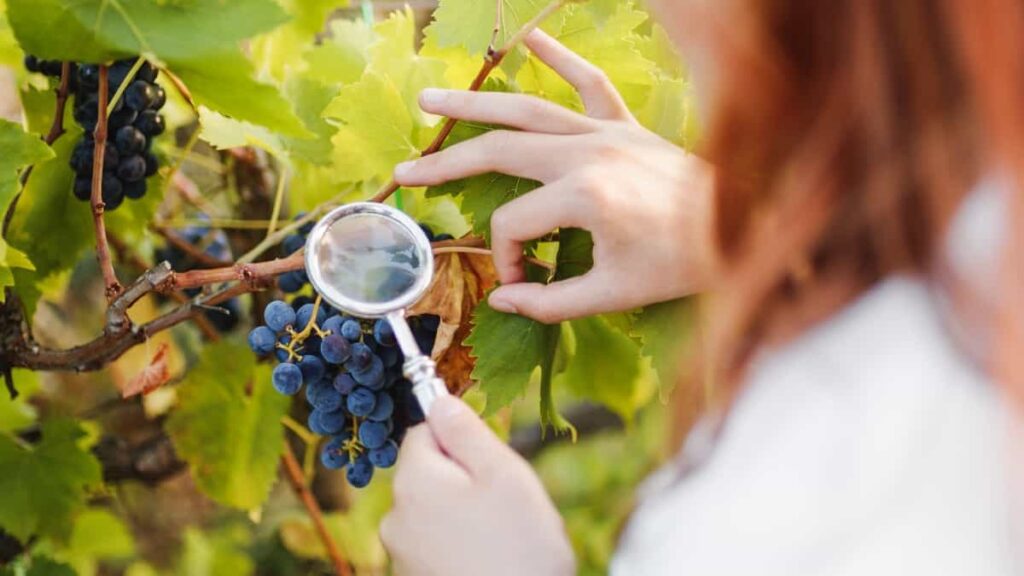
Plant Protection: Grapevine shoots, leaves, blossoms, and berries are susceptible to fungal diseases, insect pests, and nematodes. Major diseases include anthracnose, powdery mildew, downy mildew, dead arm, Botrytis, Xyantomonas, blight, and viral infections. Insect pests such as flea beetles, mealybugs, red mites, thrips, caterpillars, and soil-borne pests like nematodes and phyloxera threaten grape crops. Control measures involve the use of systemic and contact fungicides and pesticides, as well as weed control strategies.
Harvesting and Yields: The grape harvest season typically spans from February to April, with well-matured bunches containing a minimum of 180 Brix harvested. Average yields range from 20 to 30 tonnes per hectare per year for seedless varieties and 40 to 50 tonnes for seeded varieties.
Post-Harvest Handling: Harvested grapes are packed in corrugated boxes weighing 2 to 4 kg, often accompanied by grape guards or pouches for long-distance markets. Pre-cooling and the use of grape guards are essential for cold storage and export markets.
Additional Features: Grape exports are increasing, with Europe, the Middle East, and Dubai as prominent destinations. Winemaking and raisin production have also become profitable, particularly in Maharashtra and Karnataka.
January Month Grapes Orchard Maintenance Planning
In January, grape orchard maintenance focuses on pruning the grapevines. This removes dead, damaged, or diseased wood, shaping the vines for optimal growth. Pruning also helps improve air circulation and sunlight penetration, reducing the risk of fungal diseases.
February Month Grapes Orchard Maintenance Planning
February is the beginning of the grape harvest season. During this month, grape orchard maintenance involves closely monitoring the ripening process. Harvesting of early-maturing grape varieties may start in late February. Regular inspections are conducted to assess the maturity of the grapes and determine the optimal time for harvesting.
March Month Grapes Orchard Maintenance Planning
The best season for harvesting grapes typically falls between February and April. During this time, the grapes are well-matured and ready for harvest. In March, grape orchard maintenance primarily focuses on continuing the grape harvest. The remaining grape varieties mature, and harvesting continues throughout the month. Proper harvesting techniques ensure the grapes are harvested at their peak quality and flavor.
April Month Grapes Orchard Maintenance Planning
April is a crucial month for grape orchard maintenance. After the completion of the harvest, attention is given to post-harvest activities such as cleaning and sanitizing the vineyard, removing fallen leaves and debris, and managing the harvested grapes for storage or processing. This month begins the first round of pruning for new vegetative growth.
May Month Grapes Orchard Maintenance Planning
In May, grape orchard maintenance includes various activities to promote the healthy growth of grapevines. This involves fertilization to provide essential nutrients, irrigation management to ensure adequate water supply, and weed control to prevent resource competition. Regular monitoring of pests and diseases is also essential during this period.
In case you missed it: Optimizing Oil Palm Orchard Management with Month-wise Operations for High Yield and Profit
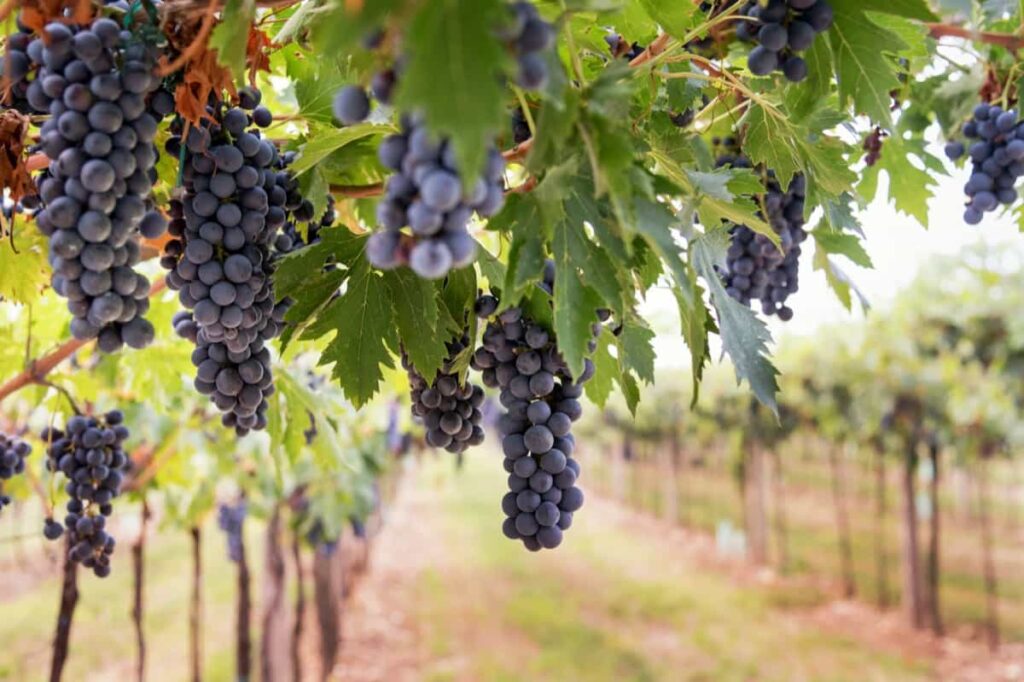
June Month Grapes Orchard Maintenance Planning
In many regions, June is the monsoon season, and grape orchard maintenance focuses on managing the vineyard. Measures are taken to prevent excessive moisture and fungal diseases. Adequate drainage systems are in place, and vineyard infrastructure is maintained to withstand heavy rains and winds.
July Month Grapes Orchard Maintenance Planning
In July, grape orchard maintenance includes ongoing management practices such as pruning, training, and shoot thinning. Pruning helps maintain the desired vine structure, while shoot thinning helps improve air circulation and sunlight penetration, reducing the risk of fungal diseases. Regular inspections for pests and diseases continue.
August Month Grapes Orchard Maintenance Planning
August is a critical month for grape orchard maintenance as it marks the second round of pruning, specifically for fruiting canes. This pruning ensures the vines are prepared for the growing season and sets the stage for optimal fruit production. The vines are trained and supported to maintain their desired shape and structure.
September Month Grapes Orchard Maintenance Planning
In September, grape orchard maintenance involves monitoring the grapevines for signs of stress or diseases. Irrigation is managed to meet the vine’s water requirements during the transitional period between monsoon and post-monsoon seasons. Nutritional needs are assessed, and appropriate fertilization is applied to support healthy growth.
The best season for planting grapes is typically from October to January. The weather is favorable for root establishment and initial growth during this time. Maintenance work for grape orchards includes activities like training the vines, pruning, fertilization, irrigation management and implementing pest and disease control measures to ensure healthy vine growth and optimal grape production.
October Month Grapes Orchard Maintenance Planning
October is a crucial month for grape orchard maintenance. It marks the beginning of the grapevine’s vegetative growth phase. Pruning is carried out to encourage new shoots and ensure the desired vine structure. Fertilization, weed control, and irrigation management continue to support the vine’s growth and development.
In case you missed it: Almond Orchard Management: Month-by-Month Maintenance Guide for Maximum Yield
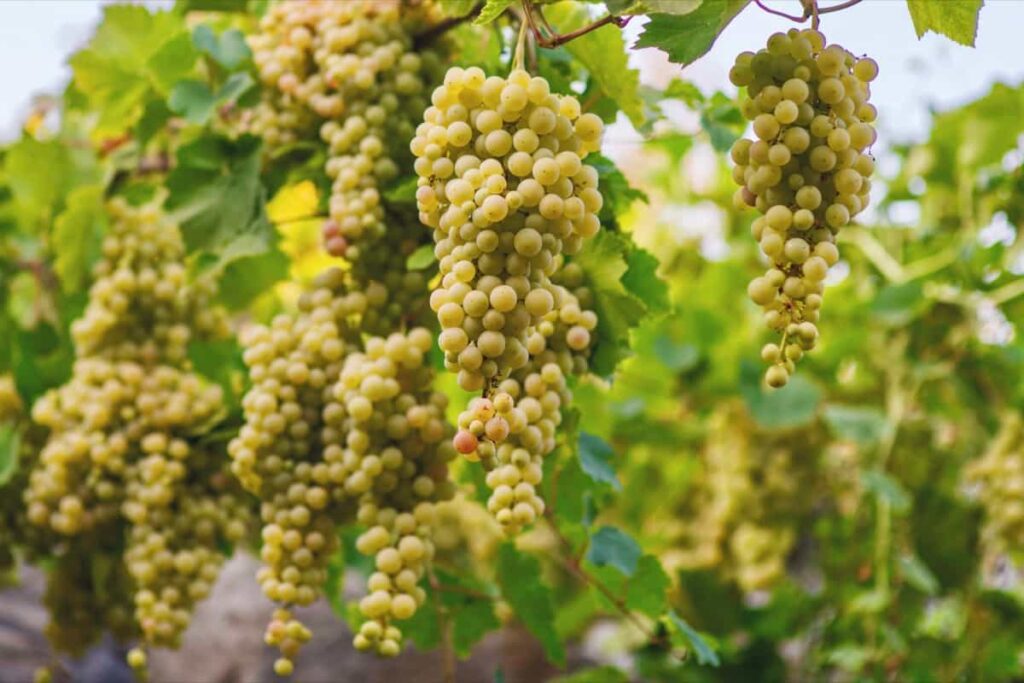
November Month Grapes Orchard Maintenance Planning
In November, grape orchard maintenance focuses on canopy management. This involves shooting thinning, leaf removal, and positioning the vine’s foliage to optimize sunlight exposure and airflow. Monitoring pests and diseases is essential, and appropriate measures are taken to mitigate any issues.
December Month Grapes Orchard Maintenance Planning
In December, grape orchard maintenance includes winter protection measures. This may involve applying protective mulch around the base of the vines to insulate the roots from cold temperatures. Vineyard infrastructure is checked and repaired if necessary. The dormant period of the grapevines provides an opportunity for general maintenance tasks and planning for the upcoming year’s activities.
Special Yearly vineyard work activities
Pruning is an essential vineyard activity carried out between December and March. It involves cutting most of the one- and two-year-old wood and older wood if necessary. Canopy management practices such as tying up shoots, blooming, leaf trimming, thinning, positioning, and cluster removal are done to maintain the desired crop level and ensure high-quality grapes.
Fertilization is based on soil and leaf analysis to provide optimal growth conditions. To prevent weed competition for water resources, floor management activities like loosening, mulching, and weeding are important during the intensive shoot growth period. Constant monitoring of diseases and pests is necessary throughout the growing season, with particular attention during the spring and summer months. Harvest time varies depending on climate, variety, and weather conditions, typically occurring between August and October in the Northern Hemisphere.
In case you missed it: Optimizing Indian Jujube/Ber Orchard Management: A Month-By-Month Operations Guide for Maximum Yield
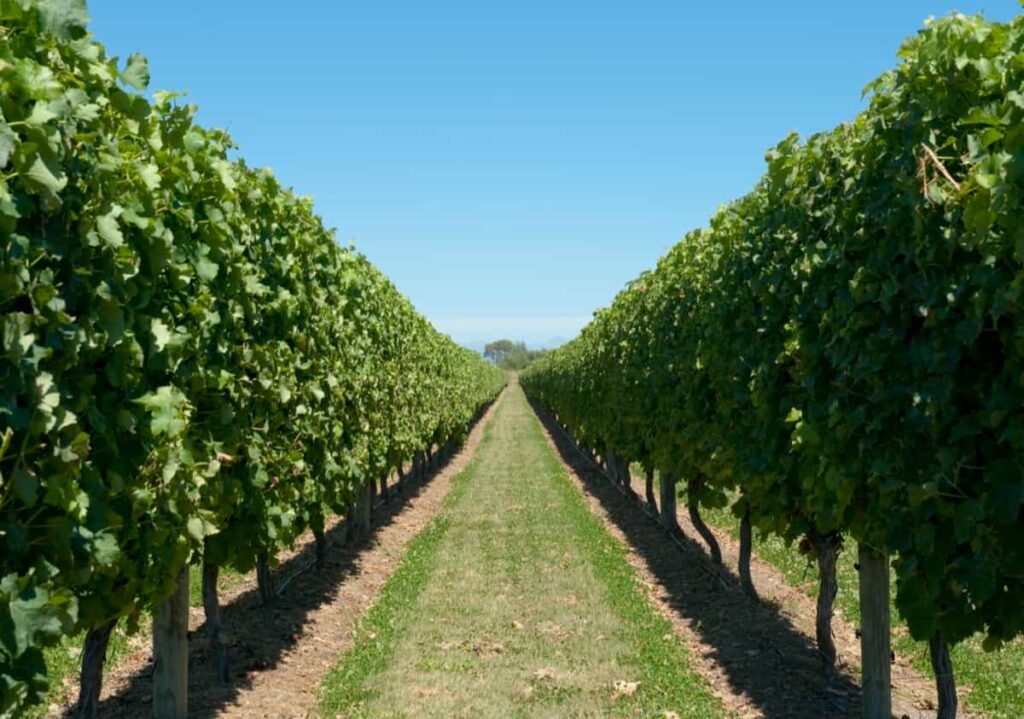
Conclusion
Optimizing grapes orchard maintenance requires a comprehensive month-wise planning approach. Grape growers can – and two-year-old wood minimize yield and fruit quality by following the recommended activities for each month, such as pruning, fertilization, irrigation, pest and disease control, and harvest management.
- Profitable Village Farming Business Ideas in 2024
- High-Yield Aquaculture: Fast-Growing Fish for Farming
- Effective Fish Pond Construction Techniques for Beginners
- Irrigation and Water Management in Pineapple Farming
- Blossom to Harvest: Mastering Flowering and Pollination in Papaya Farming
- Pig Fattening Essentials: From Selection to Sale for Beginners
- Raising Wagyu Cattle: A Complete Guide for Premium Beef Production
- Soil Types and Their Water Holding Capacity
- Optimizing Irrigation Schedules for Coconut Groves for Enhanced Yield
- Espresso Your Garden: Coffee Grounds for Healthier Acid-Loving Plants
- The Best Soil Mix for Snake Plants: How to Mix Your Own Snake Plant Soil
- Green Thumb Success: Expert Tips for Cultivating Greenhouse Beans All Year Round
- Bloom All Year Round: The Ultimate Guide to Indoor Hyacinth Care
- Eco-Friendly Gardening: How to Make Liquid Fertilizer from Kitchen Waste
- Ultimate Guide to Grow Anise in Pots: Explore Seed Propagation to Harvesting
- Guide to Raising Chester White Pigs: Discover Breed Facts to Growth Management
- Mastering the Elegance: The Ultimate Guide to Weeping Cherry Tree Care, Planting, and Maintenance
- Ultimate Guide to Planting Garlic in Grow Bags: Growing Strategies for Beginners
- How to Fix Spider Plant Leaf-Related Problems: Natural and Organic Remedies
- 10 Reasons Why Your Tulsi Plant is Shedding Leaves: Home Remedies and Solutions
- Optimizing Growth and Yield: The Advantages of Palm Bunch Ash Fertilizer
- Utilizing Neem Oil Extract as a Natural Pesticide for Hydrangea
- From Soil to Harvest: Various Ways in Which Farmers Can Use AI Tools
- Steps to Encourage and Induce Citrus Flowers: A Comprehensive Guide
- How to Fix Snake Plant Leaf-Related Issues: Natural and Organic Remedies
- Transform Your Garden into a Fragrant Oasis with Raat Ki Rani (Night Blooming Jasmine)
- Discover the Ideal Chicken Breeds for Philippine Farms
- How to Create a Poultry Egg Farm Business Plan for Profits
- Grow Lemon Cucumbers Like a Pro: Insider Techniques for Bountiful Yields
- Ultimate Guide to Caring for Your Pink Princess Philodendron: Tips for Thriving Variegation
- Areca Nut Profit Per Acre: Calculating Yield and Cost of Cultivation
- How Kaveri Chicken is Becoming a More Profitable Breed in Indian Backyards
- Transform Your Barn: 9 Steps to Convert a Horse Stall into a Chicken Coop
- Exploring Suffolk Sheep Disadvantages with Limitations and Challenges
- Guide to Solving Potted Lemon Tree Problems: How to Revive Lemon Tree in Containers
- Steps to Encourage Female Pumpkin Flowers: Best Strategies for More Flowers and High Yields
